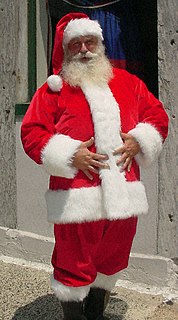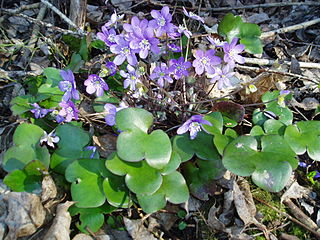
Den blomstertid nu kommer is a Swedish summertime hymn, traditionally credited to Israel Kolmodin after walking at Hångers källa outside Visby. It was first published in the 1695 Swedish Hymnal, and the Finnish translation was made for the 1701 Finnish Hymnal by Erik Cajanus.
"När det lider mot jul", also known as "Det strålar en stjärna", is a Swedish Christmas song with lyrics by Jeanna Oterdahl, and written for vocals and piano in 1909 by Ruben Liljefors. A version for mixed choir, a cappella, was added in 1933 and originally published in 1944 by Gehrmans musikförlag. The song’s later popularity is said to have been affected by publication in Gottfrid Berg’s Läroverkskören 1950 and after being recorded on record, it was heard in TV in the early 1960s.
Tomtarnas julnatt, also known as Midnatt råder or Tipp tapp, is a Christmas song with lyrics by Alfred Smedberg, and music by Vilhelm Sefve-Svensson. The song was originally published in the children’s magazine Jultomten in 1898, and has then been re-published several times. In 1916 it was published in 115 sånger för de små., According to song researcher Lennart Kjellgren the crediting of Sefve for the music is uncertain (1999).

Raska fötter springa tripp, tripp, tripp or just Raska fötter, is a Christmas song, originally published in Julklappen in 1901. The song, originally entitled Liten julvisa, describes a time when on several places in Sweden, the Christmas goat was still the Christmas giftbringer, and not Santa Claus. Sigrid Sköldberg-Pettersson (1870–1941) wrote lyrics while Emmy Köhler (1858–1925) wrote music.

"Julbocken", with the opening lines "En jul när mor var liten", is a Christmas song written by Alice Tegnér. The lyrics describe a time when the Julbocken was still a more popular Christmas gift-bringer in Sweden than the Jultomten or Santa Claus. The lyrics describe the goat giving presents, a doll for "Mother" when she was a child, who was frightened when the goat jumped; and for her brother, a drum and a trumpet. When the goat is old, he returns to "Mother", who now has children of her own.

Kring julgranen, also known as Nu så är det jul igen, jultomten myser, is a Christmas song written by Alice Tegnér, and originally published in 1899 in volume 5 of Sjung med oss, mamma!.

"Tre pepparkaksgubbar", also known as "Vi komma, vi komma från Pepparkakeland", is a Swedish Christmas song with lyrics by Astrid Forsell-Gullstrand and music by Alice Tegnér. The song was originally published in 1913, both in Bärina Hallonhätta och andra visor and volume 6 of Alice Tegnér's Sjung med oss, Mamma!.
Julvisa, also known after the opening lines Giv mig ej glans, ej guld, ej prakt, is a Christmas song written by Zacharias Topelius in 1887. It was originally published in Publicistklubben's magazine Julqvällen and appears in the fourth volume of Zacharias Topelius' Samlade skrifter. It was set to music by 30 year old Jean Sibelius in 1895.
"Bereden väg för Herran" is a Christian hymn with lyrics by Frans Michael Franzén in 1812. Britt G. Hallqvist later rewrote the final verse lyrics. Describing Jesus coming into Jerusalem, it is a popular Advent song.
Hosianna, Davids son is an Advent song with music by Abbé Vogler for mixed choir and church organ, with lyrics in Swedish-language. It's one of the more popular Christmas songs in Sweden and Finland.
Var hälsad, sköna morgonstund is an 1819 Christmas hymn with lyrics by Johan Olof Wallin. It is set to a tune composed by Philipp Nicolai., There is also an English language-version called "All Hail to Thee, O Blessèd Morn!" with lyrics by Ernst W. Olson published in the Augustana Hymnal of 1901.
Tryggare kan ingen vara is a Christian hymn with lyrics by Lina Sandell circa 1850, and published in 1855 Andeliga daggdroppar, where the writer was credited as anonymous. It was recorded by Carola Häggkvist in 1998 on the album "Blott en dag". It has also been used in the film soundtrack for the 1987 film "More About the Children of Noisy Village".
Jesus för världen givit sitt liv is an 1889 Easter song with lyrics by Lina Sandell, and 1860 music by Fredrik August Ekström. According to Koralbok för Nya psalmer, 1921, the A tune is based on an English melody, and the B-tune a Fredrik August Ekström composition. The song was recorded by Carola Häggkvist in 1998 on the album "Blott en dag".
Din klara sol går åter opp is a song with lyrics by Johan Olof Wallin, from 1814. Being a Christian morning hymn about Sunrise, it was a common morning prayer song in the Swedish primary school for decades. Johan Georg Christian Störl is often credited as composer of the tune.
Julpolska, also known as Nu ha vi ljus här i vårt hus, is a Christmas song with lyrics by Rafael Hertzberg (1845-1896) and music by Johanna Ölander (1827-1909). Song lyrics describe Christmas Eve, dated from a time when the Christmas goat at many places still was the giftbringer, not Santa Claus.
"Räven raskar över isen" is an old Swedish folksong performed as a singing game when dancing around the Christmas tree and the midsummer pole. The opening verses are often "flickornas visa" or "pojkarnas visa". After that, the verses may vary. However, the "songs" of Grin-Olle and Skratt-Olle are common.
"Ett barn är fött på denna dag" is a Swedish Christmas song.
Tomten och haren, or I ett hus vid skogens slut, is a song often used as a Christmas song, but also used as a mimic song. The song is often sung among children, and the lyrics deal with a Santa Claus/elf/tomte figure sitting inside a cottage noticing a hare, saving it from the hunter by allowing it into safety inside the cottage. The tune is of unknown origin, but is reminiscent of the Sunday school song Är du glad av hjärtat nöjd, and the Evert Taube song Flickan i Havanna.

Blåsippor, also known after the opening words Blåsippan ute i backarna står, is a children's springtime song with lyrics written by Anna Maria Roos. It was originally published as a poem in Lilla Elnas sagor in 1894. It was set to music by Alice Tegnér and published as a song in 1895 in volume 3 of "Sjung med oss, mamma!"
Jag lyfter ögat mot himmelen is hymn with lyrics by Johan Ludvig Runeberg, 1857. It was introduced to the Finnish hymnals in 1886, using an 1883 translation. In Finnish, it's called "Mä silmät luon ylös taivaaseen". The hymn also appears twice in the Swedish hymnal of 1986.






